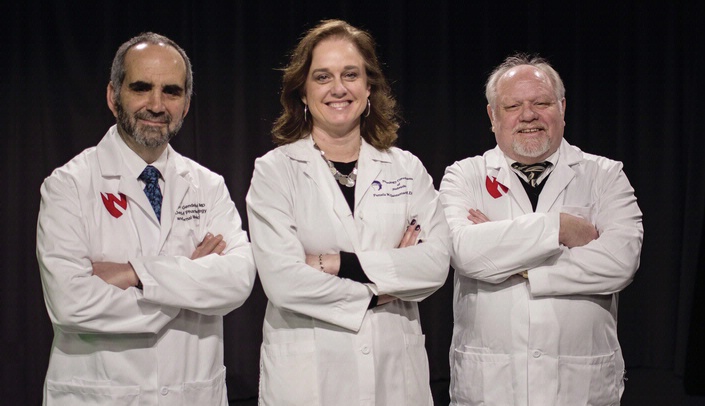Instead of discovering an entirely new drug for a disease, researchers sometimes find that an existing drug can have positive effects on a different disease.
That’s what UNMC researchers did.
In a breakthrough discovery, they found that an existing chemotherapy drug may have restorative, even curative, effects on Parkinson’s disease (PD) – a disease that ravages nearly one million Americans and generates direct and indirect costs of nearly $25 billion per year in the U.S. alone.
The drug, granulocyte macrophage colony stimulating factor (also known as Sargramostim® Sanofi-Genzyme Pharmaceuticals), was found in a Phase I human clinical trial to shift a population of white blood cells from a destructive mode to a protective state to help defend against brain injury.
The research team was headed by two UNMC scientists, Howard Gendelman, M.D., professor and chair of the department of pharmacology and experimental neuroscience, and R. Lee Mosley, Ph.D., pharmacology and experimental neuroscience professor and head of the Movement Disorders Research Laboratory. The discovery results from more than two decades of laboratory and animal investigation.
The idea was conceived in cell studies then validated in animals. During each step, immune transformation was realized with the chemotherapy drug.
Importantly, such drug-induced transformation not only has been successful for PD but also holds promise for a range of neurodegenerative disorders that include Alzheimer's disease, stroke and amyotrophic lateral sclerosis.
A Phase I, double-blind clinical study was overseen at UNMC by Pamela Santamaria, M.D., a Nebraska Medicine neurologist and founder of Neurology Consultants of Nebraska; Danish Bhatti, M.D., assistant professor in the department of neurological sciences; and by David Standaert, M.D., Ph.D., professor and chair of neurology and director of the division of movement disorders at the University of Alabama at Birmingham.
The medicine was proven safe and generally well tolerated. Side effects were minimal, but included skin irritation, bone pain and an allergic reaction. Preliminary evidence of improvement in motor skills was observed and recorded in several of the treated patients, but validation will require larger patient enrollments.
The findings – that appeared in a March issue of the journal npj Parkinson's Disease – mark a milestone for PD research. At the heart of the discovery was the immune transformation of disease-inciting circulating white blood cells (called effector T-cells or Teff) to cells that protect and defend against brain injury (called regulatory T cells or Treg). The drug changed neurodestructive Teff into functional neuroprotective Tregs.
"To our knowledge, this study represents the first time immune transformation was performed on any patient with neurodegenerative disease," Dr. Mosley said.
Dr. Gendelman said the next step will be a broader study that will include larger patient numbers. This is being planned in the next one to two years, he said, after the manufacture of an oral medicine.
Web extra
Read the npj Parkinson’s disease journal article.
